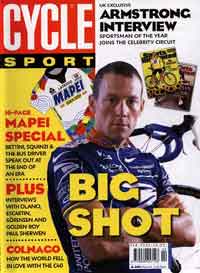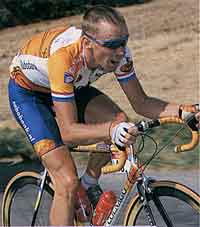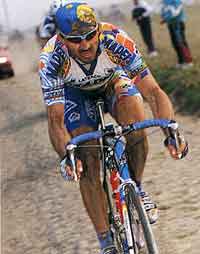
.........................................................................................................................................................................................................
societa colnago | colnago c40 | colnago c40hp | colnago c50hp | colnago dream |
colnago teams since 1968 | robert millar c40 review | colnago clx | colnago c50 2007 |
colnago arte 2008 | colnago eps | ernesto colnago interview 2008

The following article was originally printed in Cycle Sport, February 2003 and is reprinted here with full permission. the washingmachinepost is extremely grateful to Cycle Sport Managing Editor Robert Garbutt for the foregoing.cyclesport.co.uk
The Black Stuff
There have been many attempts at building a carbon fibre road bike frame. Most have been competent enough, at least in the short term. Some are excellent in most respects but lacking a little something when it comes to the overall picture.
One, however, is so right, so outstanding, so complete in concept and execution, that it seems impossible that it should have been almost a decade in production, or that in that time it should have accumulated a palmares ranging from stage races to the hardest of the one day Classics, or that it should be virtually unchanged from the original test mule. Yet all this, and more, is true of Ernesto Colnago's C40, which almost 10 years on from its first competitive appearance remains the most sought after machine in contemporary cycle culture.
Go back to the peloton of the early '90s, and the legend of the C40 becomes a little easier to explain. Here was a cycling world in thrall to tasteless Lycra clothing, where 'sports eyewear' was better suited to apres ski and the more cautious pros had yet to embrace the advantages of gearshifting at the brake lever. Aluminium alloy racing framesets were still made by bonding their tubes together, and titanium was both the the 'heir apparent' to steel as a frame material and the choice of the well heeled. A few, almost experimental, offerings in carbon fibre provided a touch of exotica, and steel tubing, ideally by Columbus and finished off with chrome plating, still ruled the roost.
Into this world of technological flux stole the C40 in disguise. It was not Colnago's first assay in carbon fibre; besides various monocoque time trial and track frames, there was the Carbitubo, which itself enjoyed considerable success in arenas as diverse as sprinting and time trialling and which was still to be seen in the bunch in the mid-Nineties. Good as it was, the Carbitubo was prone to instability on fast descents, probably due to the poor torsional rigidity of the down tube layout

A Different Beast
The C40 was different, and in order to hide its most revolutionary feature, was given a sumptuous red and yellow paintjob for the 1993 Vuelta a Espana, where it was used in the mountains by eventual winner Tony Rominger. Its painted finish left that original example looking like a lugged and bonded aluminium frame, an impression aided by the use of Colnago's scalloped, four-sided 'Master' cross-section for the top and down tubes.
The ruse succeeded, convincing onlookers that Rominger had chosen a lightweight aluminium frame for the mountain stages. In fact, the prototype, labeled 'C' for carbon fibre and '40' to celebrate the 40th Anniversary of the Colnago firm, was far lighter than the best of the contemporary competition, whether in aluminium or anything else, with the 54cm example weighing a mere 1kg minus fork.
The tryout at the Vuelta confirmed the promise of Colnago's concept, and by the end of the year World Cup winner Maurizio Fondriest of Lampre had been given the first 'official' C40. Fondriest didn't like it much and stuck with his Carbitubo, perhaps because the early examples were of optimal stiffness for a rider of around 60kg. To overcome this, the cross-sections of the top and down tubes were fattened slightly, leaving the frame optimised for a rider of nearer 80kg and adding about 100g to the weight. Other changes have been minor: the chainstays were beefed up, the down tube became one above the brake bridge to create the B-Stay model that morphed into the fabled Colnago Ferrari.
The connection with motor racing's most glamorous marque was no flash in the pan, beginning in late 1986 with collaboration on a composite frame built using both tubular and moulded solid frame members. Ferrari was working on the design of the F40 supercar at the time, exploring new ways to work with composites, and especially on ways to join structural members.
The 'composite' cycle frames then in existence simply substituted carbon fibre for metal tubes, leaving the lugs or joins in aluminium or even steel. Still in use today, this technique works well enough. However, by taking advantage of Ferrari's technology, Colnago was able to make the joints in carbon fibre composite, saving weight and, by bonding carbon fibre to itself, creating a homogenous finished structure.
Colnago's true stroke of genius, however, was to take the trouble to mould a separate 'suite' of lugs and tubes for each individual frame size, thus accommodating the minute angular differences between correctly proportioned frames of different dimensions.
This was the secret of the C40; effectively a monocoque, with the strength and resilience to be expected of a continuous structure, it was, and is also a racing frame of classical proportion, manufactured in a full range of sizes from 46cm to 64cm, each with with precisely the same geometry as Colnago's steel frame of the same size.
.
Poetry in Motion
As a solution to the problem of bicycle frame construction, the C40 was ground-breaking, but it took an artisan of Colnago's stature to turn it into a work of art. The temptation might have been to show off its cutting-edge technology by giving the frame a futuristic line. Instead, the cycle builder who has been compared to Benvenuto Cellini chose to embellish his creation with smoothed, flowing joins and beautiful lacquered and coloured finishes.
Of these, the most evocative are surely those applied to the machines ridden by Giorgo Squinzi's great Mapei Team of the mid-nineties. Given the fact that the later versions of the frame were built for the beefier cyclist, it is hardly suprising that it should have proven effective in the one-day classics. Just how effective was shown in the spring of 1995, when Johan Museeuw won the Tour of Flanders, a feat quickly matched by that of Franco Ballerini, who took Paris-Roubaix. It is said that before the start of the latter, Squinzi expressed reservations over the likely durability of the airily-light C40s of his two powerful stars. Ballerini's ride silenced the doubters, and since then the frame has been ridden to five wins in 'La Pascale'. One of them was, of course, the famous Mapei one-two-three of 1996, when Museeuw, Andrea Tafi and Gianluca Bortolami crossed the line together - on matching bikes. It is notable that the C40 did not need suspension forks, even when they were de riguer throughout the remainder of the peloton.
Perhaps inevitably, given Colnago's sponsorship of Mapei and Rabobank, the C40s palmares has a predominance of Classics riders, although Pavel Tonkov rode one in the 1996 Giro. This might give the impression of an immensely durable, but slightly overbuilt frame best suited to powerhouses such as Ballerini, Rolf Sorenson and sprinter Tom Steels.

Durable yes, in the tradition of frames by Ernesto Colnago, who has always built frames to last, with weight-saving a secondary consideration. Few, if any, broke, even under the impulsion of a stocky brute such as Sergei Soukoutcherenkov or Adriano Baffi. Overbuilt? With the C40, Colnago achived the Holy Grail of frame-builders by marrying near-indestructability with the weight of the finest aluminium framesets. It is still, even after a decade, the most desirable machine in the peloton, and the most reluctant to hand back. Ernesto has indicated that he has something special in the pipeline for his 50th anniversary. It will have to be very special indeed to eclipse the C40.
photo shows tony rominger on the original c40
![]()
since search engines often catalogue individual pages, click here to experience the full effect.
......................................................................................................................................................................................................... ernesto's corner | colnago c40 | colnago c40hp | colnago c50hp | colnago dream | robert millar c40 review | colnago clx | colnago c50 2007 |
colnago arte 2008 |colnago eps | ernesto colnago interview 2008